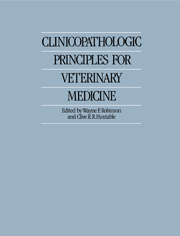Book contents
- Frontmatter
- Contents
- Contributors
- Preface
- Acknowledgements
- 1 The relationship between pathology and medicine
- 2 The immune system
- 3 The hematopoietic system
- 4 Acid–base balance
- 5 The respiratory system
- 6 The cardiovascular system
- 7 The alimentary tract
- 8 The liver and exocrine pancreas
- 9 The urinary system
- 10 The endocrine glands
- 11 The skin
- 12 The skeletal system
- 13 The nervous system
- 14 Muscle
- 15 Metabolic disease
- 16 The reproductive system
- Index
16 - The reproductive system
Published online by Cambridge University Press: 19 January 2010
- Frontmatter
- Contents
- Contributors
- Preface
- Acknowledgements
- 1 The relationship between pathology and medicine
- 2 The immune system
- 3 The hematopoietic system
- 4 Acid–base balance
- 5 The respiratory system
- 6 The cardiovascular system
- 7 The alimentary tract
- 8 The liver and exocrine pancreas
- 9 The urinary system
- 10 The endocrine glands
- 11 The skin
- 12 The skeletal system
- 13 The nervous system
- 14 Muscle
- 15 Metabolic disease
- 16 The reproductive system
- Index
Summary
When an animal suffers a reproductive problem the presenting signs may be dramatic, as in abortion or acute pyometra, but more often the animal is presented for examination simply because attempts at breeding have been unsuccessful. Furthermore, the underlying cause of infertility may no longer be present, even though the effects are still apparent. So one of the most important facets of investigating a reproductive problem is to obtain an accurate breeding history for the animal. Understanding the causes of infertility also requires an appreciation that the reproductive system is a dynamic system dependent on the finely tuned interaction of pituitary and gonadal hormones. To this end the reproductive anatomy, physiology and endocrinology of the domestic species will be reviewed briefly, before any discussion of breeding disorders.
Abnormalities of reproductive function generally follow disturbances of the normal hormonal and physiologic patterns. Such disturbances can arise from endocrine dysfunction, from invasion of the reproductive tract by pathogens or tumors, or from abnormalities of development. A number of reproductive disorders will be discussed, but the list of diseases will not be exhaustive. The object is to illustrate in principle the major dysfunctions of the system.
From a clinical standpoint the female reproductive system is intrinsically more complex and interesting, in that diseases can often be treated, or aberrant cyclic patterns modified, by the administration of exogenous hormones. In the case of the infertile male, the role of the veterinarian is usually confined to diagnosis and management advice, as treatment is often ineffective.
- Type
- Chapter
- Information
- Clinicopathologic Principles for Veterinary Medicine , pp. 399 - 418Publisher: Cambridge University PressPrint publication year: 1988



